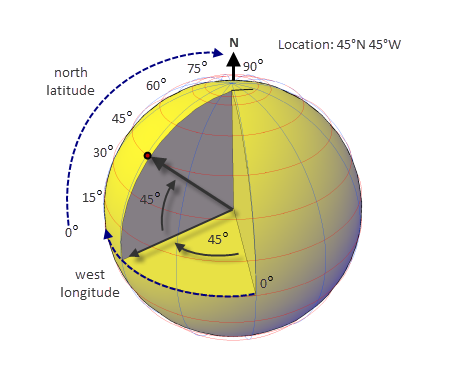Coordinate systems typically used in Geographical Information Systems (GIS) are referred to as GIS coordinate systems.
CAD coordinate systems such as UCS and WCS describe points relative to the object being modeled, not relative to a location on the surface of the Earth. GIS coordinate systems, on the other hand, describe locations on the surface of the earth. GIS coordinate systems handle significantly larger scales than CAD coordinate systems and deal with issues such as the curvature of the earth and terrain, which are insignificant to CAD coordinate systems.
There are two types of GIS coordinates systems that are commonly used. They are geographic coordinate systems and projected coordinate systems.
Geographic Coordinate Systems
Geographic coordinate systems take into account the curvature of the earth and a location is commonly specified in terms of longitude, latitude and elevation.

Because the earth is not perfectly round, no single geographic coordinate system is able to accurately define all locations on the surface of the Earth. Consequently, various organizations define local coordinate systems, where measurements are taken locally from a local datum.
Local coordinate systems are considered more accurate because they align more closely with the Earth's surface in that locality, in comparison to an Earth-centric datum. Often, more than one coordinate system may cover the location you are interested in. As a general rule of thumb, the coordinate system with its datum closest to that location is considered to be the most accurate.
Projected Coordinate Systems
Projected Coordinate Systems use a mathematical transformation to convert geographic coordinate systems into a flat 2D representation. They use linear measurements for coordinates. As such they make it possible to transform GIS coordinates to CAD coordinates.
Mapping CAD Coordinates to GIS Coordinates
When you assign geographic location information to a drawing file (GEOGRAPHICLOCATION command), you also assign a projected coordinate system to the drawing.
Typically CAD drawings are unitless and are drawn at 1:1 scale. You are free to decide the linear unit a drawing unit represents. GIS systems, on the other hand, allow the coordinate system to decide the linear units. In order to map CAD coordinates to GIS coordinates, the system needs to interpret CAD drawing units in terms of linear units. The system uses the setting stored in the INSUNITS system variable as the default linear measurement of a drawing unit. However, when you insert geographic location information, you have the option of specifying a different linear measurement (for a drawing unit).